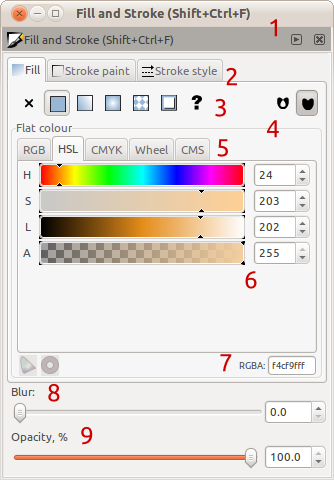Difference between revisions of "Fill and Stroke Dialog Re-Design"
Jump to navigation
Jump to search
(→Issues) |
|||
| Line 7: | Line 7: | ||
# "Fill and Stroke [...]" is repeated, as are the window controls (close, minimise etc.) We have two window-bars when one would do, and the duplication makes it not obvious that this dialog can actually dock. | # "Fill and Stroke [...]" is repeated, as are the window controls (close, minimise etc.) We have two window-bars when one would do, and the duplication makes it not obvious that this dialog can actually dock. | ||
# No padding between the tab labels and images makes it look 'cramped' | # No padding between the tab labels and images makes it look 'cramped' | ||
# While the icons are useful for long-time users, the lack of labels can confuse new users. Also it is not obvious that the buttons will change the behaviour of the selected until they are pressed and the contents below them changes | # While the icons are useful for long-time users, the lack of labels can confuse new users. Also it is not obvious that the buttons will change the behaviour of the selected until they are pressed and the contents below them changes | ||
# Yuck! Using such borders is depreciated (http://library.gnome.org/devel/hig-book/nightly/controls-frames.html.en) and clutters the dialog when white space provides the same separation but without the visual clutter. I can count at least 3 borders that just aren't needed | # Yuck! Using such borders is depreciated (http://library.gnome.org/devel/hig-book/nightly/controls-frames.html.en) and clutters the dialog when white space provides the same separation but without the visual clutter. I can count at least 3 borders that just aren't needed | ||
# The behaviour of the tabs at the top and these tabs are conflicting. The tabs at the top provides a mechanism of looking at '''completely different''' things, and notebooks should be used for (http://library.gnome.org/devel/hig-book/nightly/controls-notebooks.html.en). However the tabs here are used for looking at the '''same thing''' in a different way. | |||
# | # The items above have two much padding in between them between columns, so they look disassociated, and have too little between rows so it looks cramped | ||
# Why is this small? This is very useful and so shouldn't it be easy to click on and use? | |||
# These widgets could be both on one line, but instead there is waisted whitespace and as a results, gives a disjointed look | |||
# Opacity is given a useful unit, however Blur misses this out completely. Also this unit should be given after the number, it is not as useful on the other side of the dialog | |||
Revision as of 18:17, 7 March 2011
My name is Andrew and I have been using Inkscape for quite a while and have always found it fantastic! One thing I have found though, is that while some parts of Inkscape are brilliantly designed, some legacy parts you use a new lick of paint and a polish :)
One such part is the part I use most, the Fill and Stroke Dialog. This was also picked up recently by this blog post http://www.bomahy.nl/hylke/blog/on-gnome-and-elegance/ (yes we can all tell which application screenshots 2 and 3 are from :P )
Issues
- "Fill and Stroke [...]" is repeated, as are the window controls (close, minimise etc.) We have two window-bars when one would do, and the duplication makes it not obvious that this dialog can actually dock.
- No padding between the tab labels and images makes it look 'cramped'
- While the icons are useful for long-time users, the lack of labels can confuse new users. Also it is not obvious that the buttons will change the behaviour of the selected until they are pressed and the contents below them changes
- Yuck! Using such borders is depreciated (http://library.gnome.org/devel/hig-book/nightly/controls-frames.html.en) and clutters the dialog when white space provides the same separation but without the visual clutter. I can count at least 3 borders that just aren't needed
- The behaviour of the tabs at the top and these tabs are conflicting. The tabs at the top provides a mechanism of looking at completely different things, and notebooks should be used for (http://library.gnome.org/devel/hig-book/nightly/controls-notebooks.html.en). However the tabs here are used for looking at the same thing in a different way.
- The items above have two much padding in between them between columns, so they look disassociated, and have too little between rows so it looks cramped
- Why is this small? This is very useful and so shouldn't it be easy to click on and use?
- These widgets could be both on one line, but instead there is waisted whitespace and as a results, gives a disjointed look
- Opacity is given a useful unit, however Blur misses this out completely. Also this unit should be given after the number, it is not as useful on the other side of the dialog
